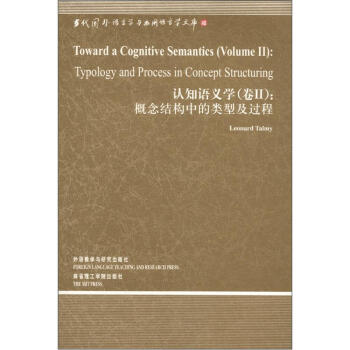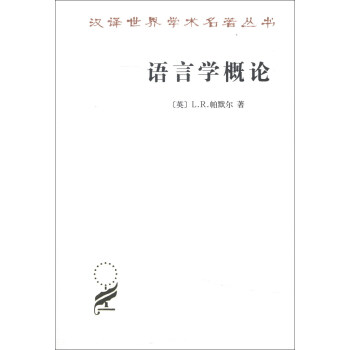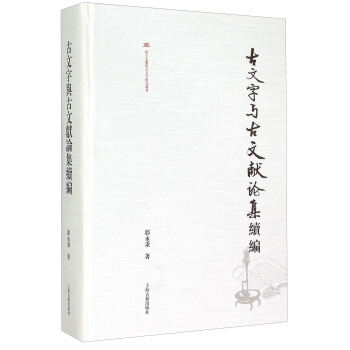

具体描述
編輯推薦
《認知語義學》(兩捲本)為認知語言學創始人、美國語言學傢Leonard Talmy傾盡心血的集大成之作。兩捲本奠定瞭認知語義學的理論基礎,是語言學領域,尤其是認知語言學領域研究者的必讀之作。《認知語義學(捲Ⅱ):概念結構中的類型及過程》為兩捲本的第二捲,主要描述概念構建過程中呈現的類型學和結構特徵。第一捲《認知語義學(捲Ⅰ):概念結構係統》主要研究概念的構建。
內容簡介
《認知語義學》(Toward a Cognitive Semantics Ⅰ&Ⅱ,2000,the MIT Press.以下簡稱“本書”或“該書”)為認知語言學創始人、美國語言學傢Leonard Talmy傾盡心血的集大成之作。本書奠定瞭認知語義學的理論基礎,是語言學領域,尤其是認知語言學領域研究者必讀之作。該書原創性強,各章理論自成體係,且包含多種理論係統。全書基於大量的語料,理論基礎牢固。該書不僅對語言學領域內的分支(尤其是語義學、句法學、類型學等)具有方嚮性的帶領作用,而且對人類學、文學(尤其是敘事學)、心理學、哲學、文化研究、神經科學及人工智能等學科中的話題也有重要影響。此書使作者一舉成為舉世公認的認知語言學創始人。《當代國外語言學與應用語言文庫·認知語義學(捲2):概念結構中的類型及過程》的核心是“概念結構係統”。作者在捲I和捲II的副書名中均使用瞭structuring一詞,錶示概念結構並不是一個靜態的結構係統,而是通過不同的認知過程“構建”(structuring)而成。
內頁插圖
目錄
IntroductionPART 1 TYPOLOGICAL PATTERNS IN THE REPRESENTATION OF EVENT STRUCTURE
Chapter 1 Lexicalization Pattems
Chapter 2 Surveying Lexicalization Patterns
Chapter 3 A Typology of Event Integration
Chapter 4 Borrowing Semantic Space: Diachronic Hybridization
PART 2 SEMANTIC INTERACTION
Chapter 5 Semantic Conflict and Resolution
Chapter 6 Communicative Goals and Means: Their Cognitive Interaction
PART 3 OTHER COGNITIVE SYSTEMS
Chapter 7 The Cognitive Culture System
Chapter 8 A Cognitive Framework for Narrative Structure
References
Index
精彩書摘
A work that reveals different parts ofitself through time can be considered intrinsically dynamic. Examples of genres of this type are conver-sation, storytelling, a play, a film, a comedy routine, an improvisational theater performance, a mime performance, a religious ceremony, a dance performance, music, video art, and kinetic sculpture.Other works are intrinsically staac, but the experiencer can interact with them by successively directing his attention to different parts of the whole. Static works may be classed into two groups on the basis of whether or not there is a cultural convention that prescribes a particular sequence in which attention is to be directed (even though it would be physically possible to direct one‘s attention elsewhere). Works that involve such a convention include a book, a cartoon strip, a sequential fresco, and an Australian aboriginal sand tracing depicting mythic treks.
Other types of static work are designed for random access by the experiencer’s focus of attention. Examples of such works are a painting or tapestry with a number of different depicted components; a sculpture designed for viewing from different angles; an architectural structure that one can view from different interior and exterior points; and a geographic-sized art work, as by Cristo, An interesting observation emerges from this analysis, Any old tapestry or painting that in effect depicts a story by showing a number of figures and activities together suggesting a succession of events, but one that the viewer must piece together through her own self-determined sequence .of visual fixations, is as much an example ofinteractive fiction as any modern computer-based form.
The prototype requirement for narrative that it be progressional is abetted to the extent that a genre exhibits a certain one of the characteristics outlined above. This characteristic is that the genre‘s partwise succession is determined-whether by physical shifts of exposure or by conventions for directing attention-rather than being open to attentional random access.
2.1.3 The Degree of Coherence and Significance The third and final factor considered here is that of Coherence and Signiftcance. A lugh degree of coherence and significance are required for the narrative prototype. Coherence is the property that the parts of the work fit together into a sensible whole. That is, relative to the average human conceptual system, the parts of the work can be cognized together in a way that they constitute a higherlevel entity that can be assessed as a unity. A work loses coherence to the extent that parts of the work are experienced as contra-dictory, irrelevant, or random with respect to each other. Significance (in its nonneutral sense) is the property that the parts and the whole of a work can be experienced as fulfilling some purpose or mission on the part of the author.
It can be seen why a prototypical narrative requires that the factor of coherence and significance be added to the previous two factors, and that all three factors have positive values. A “work” could be prototypical in being ideational and progressional but, without coherence and significance, it would hardly qualify as a narrative. An example of this combination of values is a diary or’a chronicle, which recounts a succession of ideational events but lacks story character to the extent that the entries do not cohere. A collection of references to a succession of unrelated events-whose juxtaposition would thus not only lack coherence but also significance-would be even less of a narrative. On the other hand, to the extent that a diary is seen as someone‘s personal history or “story” or that a chronicle is seen as the history or “story” of, say, a kingdom, the recounted succession of events would be accorded a sense of coherence and purpose and so come closer to being experienced as a narrative.
……
用户评价
作者的這兩本書是認知語義學領域裏的巔峰之作瞭。語義理論不斷翻新,觀點各異,學派林立。近年來,認知語義學越來越得到人們的關注和認可。認知語義學傢的一些主要觀點,如語義的經驗觀、概念觀、百科觀、原型觀、意象圖式觀、隱喻觀、寓比觀、象似觀以及認知模型和激活理論值得介紹。語義具有動態性、可變性和不確定性。 由中國認知語言學研究會主辦、湖南大學外國語學院承辦的“第三屆國際認知語義學研討會”將於2013年3月28-31日在湖南大學外國語學院舉行。語義學(英語Semantics 法語La sémantique),也作“語意學”,是一個涉及到語言學、邏輯學、計算機科學、自然語言處理、認知科學、心理學等諸多領域的一個術語。雖然各個學科之間對語義學的研究有一定的共同性,但是具體的研究方法和內容大相徑庭。語義學的研究對象是自然語言的意義,這裏的自然語言可以是詞匯,句子,篇章等等不同級彆的語言單位。但是各個領域裏對語言的意義的研究目的不同:喬治·雷可夫:認知語言學的其中一位創立者,提倡隱喻是人類日常語言活動中的必須認知能力。
评分好東西,很喜歡, 很不錯的
评分挺好的 很喜歡 留著以後漫漫看
评分對這個內容評分比較高。
评分書是認知語義學的經典必讀書,不過因為供貨緊張所以送達很慢
评分印刷清晰,內容不錯,價格閤理
评分喜歡這套書喜歡這套書
评分作者的這兩本書是認知語義學領域裏的巔峰之作瞭。語義理論不斷翻新,觀點各異,學派林立。近年來,認知語義學越來越得到人們的關注和認可。認知語義學傢的一些主要觀點,如語義的經驗觀、概念觀、百科觀、原型觀、意象圖式觀、隱喻觀、寓比觀、象似觀以及認知模型和激活理論值得介紹。語義具有動態性、可變性和不確定性。 由中國認知語言學研究會主辦、湖南大學外國語學院承辦的“第三屆國際認知語義學研討會”將於2013年3月28-31日在湖南大學外國語學院舉行。語義學(英語Semantics 法語La sémantique),也作“語意學”,是一個涉及到語言學、邏輯學、計算機科學、自然語言處理、認知科學、心理學等諸多領域的一個術語。雖然各個學科之間對語義學的研究有一定的共同性,但是具體的研究方法和內容大相徑庭。語義學的研究對象是自然語言的意義,這裏的自然語言可以是詞匯,句子,篇章等等不同級彆的語言單位。但是各個領域裏對語言的意義的研究目的不同:喬治·雷可夫:認知語言學的其中一位創立者,提倡隱喻是人類日常語言活動中的必須認知能力。
评分是正版,是認知語義學的經典之作
相关图书
本站所有內容均為互聯網搜索引擎提供的公開搜索信息,本站不存儲任何數據與內容,任何內容與數據均與本站無關,如有需要請聯繫相關搜索引擎包括但不限於百度,google,bing,sogou 等
© 2025 tushu.tinynews.org All Rights Reserved. 求知書站 版权所有















![數碼人類學 [Digital Anthropology] pdf epub mobi 电子书 下载](https://pic.tinynews.org/11561032/54499cadN07aa57d5.jpg)


![卡耐基口纔訓練 [Public Speaking And Infiuecing Men In Business] pdf epub mobi 电子书 下载](https://pic.tinynews.org/11720266/559de83aN701ca7c6.jpg)
![多元智能理論與兒童的學習活動 [Project Spectrum:Early Leabning Activities] pdf epub mobi 电子书 下载](https://pic.tinynews.org/11722382/55a316a1Nb7803dbb.jpg)
